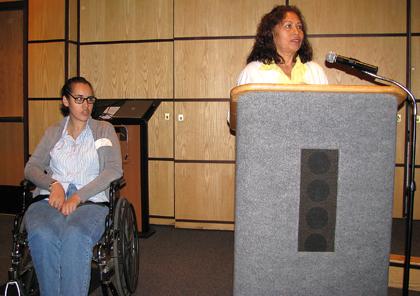By Philip Newman
Pedestrian motor vehicle accident survivors, some weeping with emotion, came to Elmhurst Hospital Center last week and thanked the surgeons who rebuilt their shattered bodies.
The occasion was a forum Friday at Elmhurst, one of the nation's leading trauma centers, to discuss what to do about the problem of pedestrians who get run down by vehicles, a type of accident which shows little sign of abating.
Teresa Ruiz, who came to New York City from Mexico and now lives in Sunnyside, said her daughter, Karina, then 17, was struck down at Skillman Avenue and 41st Street in 2004.
“Now she is almost 21,” Ruiz said through an interpreter as she told a moving story of the long road back from the day when she was told Karina probably would not survive, so grievous were her injuries.
“But my daughter lived and then they told me she probably would be in a coma,” Ruiz said, describing the painful progress made by her daughter, who briefly greeted the gathering from her wheelchair.
Ruiz said Karina spent 10 months in physical therapy at Mount Sinai Hospital.
“I give her an hour of therapy every day,” Ruiz said.
The day-long forum at Elmhurst, in Jackson Heights, involved physicians from Elmhurst and Bellevue hospitals, transportation and traffic safety experts and elected officials.
Elmhurst Hospital Center treated 1,639 pedestrians hit by motor vehicles from 2000 to 2007. The only category in which there were more cases was stab wounds, with 1,678.
Queens Boulevard has long been notorious as a dangerous place for pedestrians, but traffic authorities said sections of Northern Boulevard and Roosevelt Avenue had become increasingly dangerous to those who walk.
Several of those struck by motor vehicles praised the trauma center and its doctors, some with voices breaking and eyes tearing as they recounted their ordeals.
“We hear a great deal about reckless drivers and that is an important factor,” said Dr. George Agriantonis, director of trauma at Elmhurst. “But what about reckless pedestrians? “One example — particularly in Manhattan — is to see masses of people walking against a red light even as cars speed toward them honking.”
Several audience members cited Mothers Against Drunk Drivers as an example to follow in trying to bring down the number of pedestrian accidents.
MADD has brought higher penalties in a number of states for driving while intoxicated convictions through its information campaigns and legislative lobbying.
Others suggested advertising campaigns adopting a motto, such as the “If You See Something, Say Something” used by the Metropolitan Transportation Authority about suspicious packages.
In downtown Flushing the city has calibrated lights at 25 intersections to give senior citizens more time to cross and installed a divider on Bowne Street where the elderly can pause as part of a pilot program.
“Senior citizens represent only 12 percent of our population, but they are nearly 40 percent of those killed or seriously injured in traffic accidents,” city Department of Transportation Commissioner Janette Sadik-Khan said at the unveiling of the Flushing safety measures.
Howard Sickles, deputy chief of EMS at Fort Totten, told the Elmhurst Hospital forum there 725 pedestrian accidents on average a month in the city, no more than 1 percent to 2 percent of which were fatal.
“Of the emergencies we respond to, the numbers of gunshot wounds, falls and many other such incidents have declined, but not pedestrian accidents,” Sickles said.
Sickles said SUVs cause worse injuries to pedestrians than regular cars.
“Whereas cars tend to strike someone at the knee or below, SUVs strike the hip area, with the potential to cause internal as well as exterior injuries,” Sickles said.
The number of pedestrian accidents citywide declined only slightly, then rose again between 1998 and 2007, according to DOT statistics.































